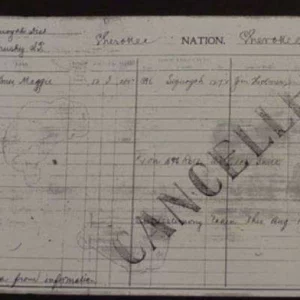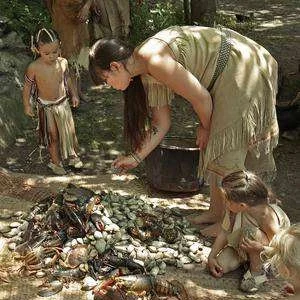Embark on a journey through the vibrant tapestry of Native American heritage as we explore authentic blankets.
The history of Native American blankets is deeply intertwined with the rich cultural tapestry of Indigenous peoples across North America. Blankets played a significant role in the daily lives, ceremonies, and cultural practices of various Native American tribes. Even today, blankets still hold an important part of ceremonies, Pow Wows, and daily life.
First, let's look back at the history of Native American blankets, and then I'll tell you about my favorite places to shop for blankets!
History of Native American Blankets
Before contact with Europeans, Native American tribes crafted blankets from natural materials such as animal hides, plant fibers, and feathers. Early blankets were often utilitarian, serving as protection against the elements and providing warmth in diverse climates.
Introduction of Trade Blankets
With the arrival of European traders in the 18th and 19th centuries, trade blankets became highly sought after by Native American communities. The Hudson's Bay Company, based in Canada, was a prominent supplier of trade blankets, known for their distinctive stripes. These blankets became known as Hudson's Bay point blankets.
Pendleton and Indian Trade Blankets
In the late 19th century, Pendleton Woolen Mills, based in Oregon, began producing Indian trade blankets. These blankets incorporated Native American-inspired designs and became popular trade items. Pendleton's blankets often featured intricate patterns and were highly valued for their quality and craftsmanship.
Government-issued Blankets
The distribution of government-issued blankets to Native American tribes during the 19th and early 20th centuries became a poignant chapter in the complex history of Euro-American and Indigenous interactions. While ostensibly intended as a form of aid, these blankets, often sourced from military surplus and lacking proper sanitation, inadvertently became vectors for the spread of diseases. The tragic consequences of this well-intentioned but misguided effort were particularly evident during periods of forced relocation and confinement, such as the infamous Trail of Tears. Blankets carrying infectious agents, including smallpox, were unwittingly introduced to vulnerable populations, leading to devastating outbreaks that decimated Native communities. This historical episode underscores the unintended and tragic consequences of cultural and health interactions, leaving a lasting impact on Indigenous populations and contributing to the broader narrative of the challenges faced by Native American tribes during a turbulent period in history.
Contemporary Revival
In recent decades, there has been a revival of traditional Native American blanket-making. Many Indigenous artists and businesses, such as those mentioned below, have emerged, creating blankets that celebrate cultural heritage while incorporating contemporary styles.
Today, Native American blankets continue to be cherished both within Indigenous communities and by people worldwide who appreciate the artistry, cultural significance, and historical resonance embedded in these unique textiles.
By selecting products from these businesses, you not only acquire exquisite blankets but actively participate in the conservation of Indigenous heritage. Wrap yourself in the warmth of history and celebrate the enduring spirit of Indigenous art and culture with every blanket.
Eighth Generation
Eighth Generation proudly stands at the forefront of authenticity. This remarkable brand is the first Native-owned business to commercialize authentic, Native-designed wool blankets. Founded by Louie Gong, a visionary artist renowned for fusing traditional Coast Salish art with contemporary influences, Eighth Generation has reclaimed a market dominated by non-Native entities.
Louie Gong's artistic vision and dedication to authenticity have played a pivotal role in Eighth Generation's success and growth. The Signature Series Wool Blankets made history in 2015, marking a significant moment when Native artists reclaimed their rightful space in the industry.
Eighth Generation is deeply committed to both environmental sustainability and cultural empowerment. They have introduced eco-friendly methods in their business approach. Additionally, Eighth Generation's “Inspired Natives™ initiative,” actively empowers cultural artists while addressing the economic consequences of cultural appropriation. The artists that create designs for Eighth Generation are paid an ongoing commission on sales, a revolutionary change in blanket design.
Furthermore, their Gold Label collection, handcrafted in Seattle, includes Merino wool throws and comfortable cotton/wool blend baby blankets while maintaining a strong focus on sustainability through their partnership with eco-friendly vertical mills.
Teton Trade Cloth By Lenape
Teton Trade Cloth by Lenape is a testament to the celebration of Indigenous heritage. Proudly owned by the Delaware Tribe of Indians and led by a Lenape woman as its CEO, this 100% Native-owned business embraces a deep respect for culture.
“Lenape,” translating to “Original People” in their native tongue, embodies inclusivity, inviting everyone to appreciate Indigenous art and traditions.
Teton Trade Cloth provides a unique platform for Native artists to express themselves authentically. Every product proudly displays the original artist's name and Nation, ensuring a genuine thread runs from conception to creation. Their product catalog is a treasure trove that includes exquisite woolens and beautifully designed blankets, harmonizing tradition with modernity.
Choosing Teton Trade Cloth goes beyond acquiring a stunning piece of Indigenous craftsmanship. It extends to supporting Indigenous artists and communities. Moreover, the company is committed to making a positive impact by contributing to Family and Children's Services, an organization that aids those affected by domestic violence and abuse.
Teton Trade Cloth by Lenape offers a mix of Wool and Cotton fabrics, ensuring a cozy and comfortable experience.
Mahota Textiles
Mahota Textiles proudly holds the distinction of being the first tribally owned textile company in the United States. Their inspiration draws deeply from the rich and diverse heritage of the Southeastern tribes, paying homage to the cultures, traditions, and stories that have shaped their communities for generations.
At the heart of Mahota Textiles lies their Tributes Collection, a stunning representation of their commitment to weaving with integrity and authenticity. These blankets feature a carefully selected palette of analogous colors that serve as a heartfelt tribute to the sacrifices and ancestral tales of the Chickasaw people.
Mahota Textiles goes beyond the ordinary with their Artisan Collection, crafted from super-soft 100% Egyptian Cotton. These lightweight and breathable blankets are not just products; they are a testament to the deep cultural significance of Southeastern tribes.
What sets them apart is their collaboration with Native American artisans, ensuring that every blanket is a work of art in its own right. Mahota Textiles pays homage to the Chickasaw heritage with stunning design options like the Chickasaw Map, Eagle, and Sun Symbol. These designs weave tales of tradition and culture.
If you ever encounter an issue with your Mahota Textiles product, their responsive customer service team can be reached via email. They accept returns of clean, unworn, and unwashed merchandise within 30 days of shipment, offering both exchanges and refunds, ensuring you're satisfied with your purchase.
One of Mahota Textiles' most remarkable qualities is its ability to interweave tradition and modernity seamlessly into its textiles. Each thread in their blankets tells a story, connecting the past with the present and preserving a heritage that deserves to be celebrated.
Boy Chief Trading Company
The mission at Boy Chief Trading Company is clear: to preserve and celebrate Indigenous culture and tradition by creating high-quality blankets. Their premier product, the 64×80-inch Boy Chief Blanket, goes beyond being mere fabric; it represents a sumptuous artifact that encapsulates a rich history of resilience, bravery, and survival.
The Boy Chief Blanket is more than just a blanket; it's a testament to the enduring power of tradition. This luxurious piece of history is intricately woven with stories passed down through generations. It serves as a tangible reminder of the rich cultural heritage of the Indigenous peoples, specifically the Blackfoot Nation.
One of Boy Chief Trading Company's standout collections is the Blackfoot Peoples Mountain Blanket Collection. This collection pays heartfelt homage to the Blackfoot culture, a culture deeply rooted in the land and its stories. The blankets in this collection feature earthy colors and intricate geometric symbolism, carefully selected to convey the profound narratives of life, death, and rebirth. The collection's name, “Blackfoot Peoples Mountain Blanket Collection,” is a tribute to their great grandfather and Blackfoot warrior, ‘Boy Chief.' This blanket collection doesn't just preserve his legacy; it actively promotes and shares the essence of Blackfoot culture and tradition with the world.
Pendleton
Pendleton Woolen Mills has a significant and complex history of incorporating Native American patterns into its textiles. Established in 1863 in Oregon, Pendleton initially focused on producing high-quality woolen blankets for trade with Native American tribes. However, it was not until the early 20th century that the company began to actively integrate Native American-inspired designs into its products.
In the 1900s, Pendleton introduced the Indian Trade Blanket, a line that featured vivid geometric patterns and bold colors inspired by traditional Native American motifs. These blankets were created in collaboration with Native American artists and weavers who contributed to the distinctive designs, incorporating symbols that held cultural significance for various tribes.
Pendleton's iconic Chief Joseph blanket, introduced in the early 1920s, is one of the most well-known examples of this collaboration. Named after Chief Joseph of the Nez Perce Tribe, the blanket's design pays homage to the rich artistic heritage of Native American tribes.
PowWows.com earns commission from Amazon.com
Throughout the decades, Pendleton continued to work closely with Native American communities, employing tribal artists and designers to create unique and culturally authentic patterns. These collaborations have extended beyond blankets to include other textiles, clothing, and accessories.
While Pendleton has received acclaim for its efforts to showcase and preserve Native American artistry, the company has also faced criticism and controversy. Some argue that the commercialization of Indigenous designs raises questions about cultural appropriation and commodification. Pendleton has responded to these concerns by highlighting its ongoing commitment to respecting and acknowledging the contributions of Native artists and weavers.
In recent years, Pendleton has expanded its efforts to support Native communities, launching initiatives like the American Indian College Fund Blanket, hiring Native artists, and contributing to causes that benefit Indigenous people.
In concluding our exploration of these five distinguished brands—Teton Trade Cloth, Eighth Generation, Pendleton, Mahota Textiles, and Boy Chief Trading Company—we find ourselves enveloped in the rich tapestry of Indigenous heritage and artistry.
Through these blankets, we traverse a landscape where tradition meets modernity, and every thread tells a story that connects the past with the present. By choosing these products, we not only acquire exquisite blankets but actively contribute to the conservation of Indigenous heritage. As we wrap ourselves in the warmth of history, let us remember that these blankets are more than mere fabric—they are a celebration of the enduring spirit of Indigenous art and culture.






Mike Marmon
says:I have always wondered where the angle designs came from on blankets and cloth , the Idea Plane ? And how did the Plains Tribes dress in severe cold ?
Paul G
says:Before blankets, they used fur. The bison fur and bear fur made great robes and coats.